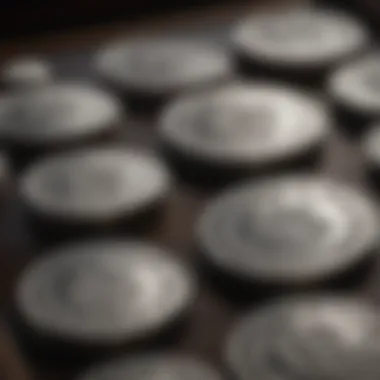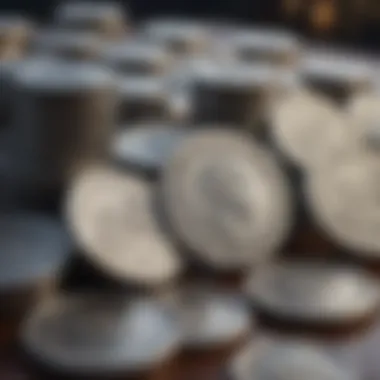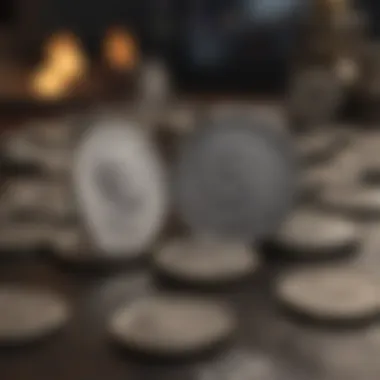Taiwanese Silver Coins: History, Design, and Market Trends


Intro
Taiwan boasts a fascinating and complex history when it comes to its silver coins. Not merely pieces of currency, these coins tell stories of cultural exchange, economic shifts, and national pride. As interest in numismatics grows, there is an increasing appreciation for Taiwanese silver coins, particularly among investors and collectors. This exploration delves into their historical significance, striking design elements, and the current market trends that govern their value.
Understanding the intricacies of these coins not only enriches one's collecting journey but also provides critical insights for investment strategies. This isn't just a hobby; it’s a pathway to appreciating history while managing financial assets. As we proceed, we’ll cover key terminologies in investment, expert advice, and the compelling nuances that define this captivating topic.
Investment Terminology
Definition of Key Terms
When stepping into the realm of coin collecting, it helps to be speaking the same language. Here are some essential terms to familiarize yourself with:
- Numismatics: The study or collection of currency, including coins, tokens, paper money, and related objects.
- Mintage: The number of coins produced in a specific year and condition. A lower mintage often translates to higher demand.
- Grading: A system to assess the condition and quality of coins, impacting their value significantly.
- Proof Coin: A special coin struck using a polished die that results in a mirror-like finish, attracting collectors.
Explanation of Complex Concepts
While some terms are straightforward, others might require a bit more unpacking.
- Market Liquidity: Refers to how easily an asset, like a silver coin, can be bought or sold in the market without affecting its price. Coins with higher liquidity tend to have more stable prices.
- Overton Varieties: In Taiwanese silver coins, some coins may have subtle differences in design. Identifying these varieties can lead to significant differences in value.
"In numismatics, every coin has a tale to tell; the challenge is in knowing how to listen to it."
Expert Advice
Best Practices for Investment
Investing in Taiwanese silver coins isn’t just about pouring money into shiny metal. Here are some prudent approaches:
- Educate Yourself: Research the specific coins you’re interested in. Resources like Wikipedia can be invaluable.
- Start Small: Especially for beginners, starting with less expensive coins can offer a learning curve without breaking the bank.
- Preservation Matters: Store coins properly to maintain their condition, which is vital for retaining value.
Tips from Financial Experts
Glean advice from those who've navigated these waters. Industry veterans recommend:
- Join Collector Communities: Platforms like Reddit provide a space for discussion and insights.
- Utilize Social Media: Follow groups on Facebook where collectors share tips and trends in real-time. Doing so can keep you informed on the rapidly changing market.
By building your knowledge base and leveraging community resources, you can enhance your experience in collecting and investing in Taiwanese silver coins.
Prelude to Taiwanese Silver Coins
Taiwanese silver coins hold a unique and significant place in the realm of numismatics. Not only are these coins prized for their aesthetic beauty and craftsmanship, but they also serve as tangible pieces of Taiwan's rich history and culture. This section aims to provide a thorough introduction to the topic, delving into both their definition and classification, as well as the broader historical context that surrounds them.
Definition and Classification
At its core, Taiwanese silver coins can be defined as currency minted in Taiwan that primarily comprises silver. Historically, silver has been valued for its intrinsic qualities, making these coins not merely a medium of exchange but also collectible items. The classification of these coins often depends on several factors: the era of minting, the minting techniques used, and the denominations involved.
Coins produced during different periods often bear distinct characteristics, reflecting the influences of various governing bodies and cultural shifts. For instance, coins minted during the Japanese Colonial period feature designs that pay homage to Japanese motifs, while post-war coins showcase elements more representative of Taiwanese culture. This classification not only facilitates a better understanding of the coins themselves but also aids collectors in identifying and valuing them.
Historical Context
The history of Taiwan's silver coins is a complex tapestry woven through centuries of colonialism, economic changes, and shifts in societal values. To appreciate these coins fully, one must consider the historical context from which they emerged.
From the Qing Dynasty to the Japanese occupation and beyond, each phase of Taiwan's history has left its mark on the design and functionality of its silver coins. For example:
- Qing Dynasty Era (1683-1895): Coins during this period often featured traditional designs and were integral in trade and commerce.
- Japanese Colonial Period (1895-1945): The Japanese introduced modern minting techniques, producing coins with intricate designs that reflected their own cultural identity alongside Taiwanese influences.
- Post-1945 Era: Following the end of World War II, new coin designs emerged that mirrored Taiwan's political and economic transformations, signifying a shift towards a more Westernized aesthetic.
Understanding the historical context of Taiwanese silver coins is crucial for collectors and investors alike. It not only reveals the evolution of minting practices but also provides insights into the economic conditions of Taiwan throughout its history.
"Coins are not just pieces of metal; they are a reflection of the society and time from which they originate."


In summary, the introduction of Taiwanese silver coins is foundational in appreciating their value, historical significance, and collectible nature. As we progress into the main body of the article, we will further explore these elements in detail.
The Historical Significance of Taiwan's Silver Coins
Taiwan's silver coins serve as more than mere currency; they encapsulate the rich tapestry of the island's history and cultural evolution. Understanding their significance involves delving into the complex interplay between colonial influences and the subsequent shaping of Taiwanese identities. These coins provide a tangible link to Taiwan’s past, reflecting not only economic transactions but also the broader socio-political contexts of different eras.
The study of Taiwanese silver coins reveals aspects of local craftsmanship, migratory patterns, and international trade dynamics. From the colonial times when foreign powers minted their own currency, to the modern evaluations that incorporate these histories into collectible frameworks, each coin tells a story worthy of exploration. This significance is particularly substantial for collectors and investors who appreciate both the financial and historical elements embedded in these artifacts.
Colonial Era Coins
During the colonial era, Taiwan witnessed a diverse array of foreign powers vying for control, significantly shaping its numismatic landscape. The Dutch colonial period from 1624 to 1662 saw the introduction of coins that were sometimes made of silver, reflecting European trading practices. One notable example includes the "East India Company coins". These were crafted to facilitate trade within the burgeoning colonial markets and represent a fusion of local and foreign influences.
Then came the Kingdom of Tungning that introduced its own currency before the Qing Dynasty took over. The Qing authorities issued a range of coins, often featuring intricate designs that captured symbols significant to both Chinese culture and Taiwan's unique identity. Silver dollar coins, like the 1900 "Yuan Shih-kai coins", not only display the monetary value but also embody the artistry and craftsmanship of the period. These coins provide historians with insights about trade routes and economic relationships between regions during Taiwan’s colonial past, revealing much about its status in the global circulation of precious metals.
- Key Features of Colonial Era Coins:
- Crafted under foreign influence, mixing designs and meanings.
- Reflects socio-political power dynamics of the time.
- Provides insight into Taiwan's economic history and trade relationships.
Post-Colonial Developments
Following the end of colonial rule, Taiwanese silver coins evolved significantly, particularly after the establishment of the Republic of China in 1949. This period marked a shift not only in governance but also in currency minting practices. Coins began to reflect a national narrative, focusing on symbols that resonated with Taiwanese identity, such as the majestic Formosan black bear or the island's natural landscapes.
The government instituted systematic minting policies that emphasized the use of silver in coins, especially during the forties and fifties, when economic stability was being sought. Collectors and enthusiasts recognize coins like the "Taiwan 1955 ten dollar" piece, which features the portrait of Sun Yat-sen, as crucial to understanding the evolution of currency in Taiwan as these coins symbolize the transition from foreign rule to a local identity.
Moreover, the alloy used in post-colonial coins, mixed with various other metals, showcased advancements in minting technology and an evolving understanding of precious metals.
- Highlights of Post-Colonial Developments:
- Introduction of nationalistic symbols during different political regimes.
- Reflection of Taiwan's evolving identity and economic landscape.
- Continuous innovation in minting techniques reflecting global standards.
Design Elements of Taiwanese Silver Coins
The design elements of Taiwanese silver coins hold a wealth of significance, weaving a rich tapestry of history, culture, and artistry that captures not just the eye but the imagination. The intricate designs, symbols, and techniques used in minting these coins help convey a narrative—a story of Taiwan's heritage, values, and the evolution of its economy. When delving into the world of Taiwanese silver coins, understanding their design elements provides collectors and investors alike deeper insight into the significance and potential value of these collectibles.
Iconography and Symbolism
When one looks closely at the iconography on Taiwanese silver coins, it becomes clear that each design choice is deliberate, often grounded in cultural significance. For instance, the image of the Formosan black bear represents not just the natural beauty of Taiwan but also national pride. Similarly, motifs inspired by traditional folklore or significant historical events can be seen, like the depiction of Taiwan's National Palace Museum, which symbolizes cultural heritage.
Many designs utilize common symbols found within Taiwanese culture, such as dragons or phoenixes, which evoke notions of prosperity and good fortune. Consider the Yuanbao or golden ingots featured in some coins—these are not just decorations but carry deep meanings related to wealth and abundance. Each symbol used in these coins is like a window into the beliefs and values that have shaped Taiwanese identity through the ages.
"The power of symbols transcends time, offering a bridge between past and present, reflecting the spirit of a nation."
Minting Techniques
The methods used in the minting of Taiwanese silver coins reflect a blend of traditional craftsmanship and modern technology. Minting is not merely a mechanical process; it’s an art form that involves skilled artisans who pay careful attention to detail. Techniques like die engraving and striking bring the designs to life, ensuring that even the smallest elements are meticulously rendered. Additionally, certain techniques are unique to Taiwan and have evolved through centuries, enhancing the distinctiveness of their coins.
For example, proof coins are meticulously prepared using special processes that ensure a mirror-like finish, making the designs pop with vibrant clarity. This technique not only adds to the aesthetic appeal but also increases the coins' collectible value. Additionally, the introduction of digital minting techniques has allowed for even more intricate designs that push the boundaries of artistry.
Materials and Quality
The materials used in the production of Taiwanese silver coins significantly impact their quality and value. Most Taiwanese silver coins are made of .999 fine silver, meaning they contain 99.9% pure silver, which is a prime standard in the numismatic world. This high level of purity not only enhances the visual allure but importantly, contributes to the coin's long-term value as precious metals often fare well against inflation and market fluctuations.
In terms of quality, grading systems utilized by professional numismatists—like the Professional Coin Grading Service (PCGS)—play a pivotal role. Coins are assessed for quality from Mint State to various grades indicating wear and tear. This grading profoundly affects the market price and desirability among collectors. A well-preserved coin may command a premium, making it imperative for collectors to understand the nuances of how care and preservation can enhance their investment over time.
In summary, understanding the design elements of Taiwanese silver coins unveils the rich history and artistry embedded in each piece. With elements like iconography and minting techniques reflecting cultural significance, along with the quality ensured by the materials used, these coins emerge as not just collectible items, but as vital fragments of Taiwan's identity and economic history.
Market Trends and Valuation
Understanding the market trends and valuation of Taiwanese silver coins is a cornerstone element in appreciating their place within the broader numismatic landscape. It serves not just as a reflection of historical value but also sheds light on upcoming investment opportunities for both seasoned collectors and novice investors drawn into this fascinating niche. In a world where market dynamics shift like sand on the beach, being well-versed in these trends is crucial for making well-informed investment decisions.
Current Market Dynamics


The market for Taiwanese silver coins has seen a surge of interest in recent years, driven by various factors. Some of the primary currents in this evolving tide include:
- Global Economic Conditions: When economies face uncertainty, demand for precious metals, including silver, often rises. Collectors and investors look for safe havens, and silver coins become a tangible asset in these times.
- Collector Communities: The rise of online forums and platforms, such as Reddit and Facebook, where enthusiasts share insights and trade, has fostered a vibrant community around Taiwanese silver coins. This social aspect of collecting provides real-time data on trends and prices, impacting market dynamics.
- Cultural Significance: As Taiwan’s historical narrative continues to gain international recognition, more collectors are drawn to Taiwanese coins for their cultural and artistic values, further stoking demand.
These factors combined create a rollercoaster effect, where prices fluctuate based on both sentiment and empirical data, keeping collectors and investors on their toes.
Factors Influencing Value
Various elements come into play when determining the value of Taiwanese silver coins. Among the key aspects are:
- Rarity: Coins that were minted in limited quantities or those that come with historical significance tend to have a higher valuation. For example, early 20th-century colonial coins present a unique allure due to their limited availability in pristine condition.
- Condition: The condition of a coin is typically assessed using grading systems such as the Sheldon Scale. Coins rated higher, reflecting better preservation, are valued more. For instance, an MS-65 coin can fetch prices much higher than one graded as a good condition.
- Market Trends and Sentiment: Public interest, auction results, and even social media discussions can shift perceived value practically overnight. If a certain coin gains visibility due to a featured article or post, its value can spike unpredictably.
Understanding these factors is essential for anyone looking to dive into the Taiwanese silver coin market, as they entirely shape investment outcomes.
Investment Opportunities
For those considering investment in Taiwanese silver coins, numerous opportunities exist, depending on budget and goals:
- Key Dates and Rarities: Look for coins that are recognized as key dates within their series. These often appreciate significantly over time.
- Bulk Purchases: Investing in bulk lots from dealers or auctions can sometimes offer hidden gems. Coins that appear less exciting can appreciate more as the market evolves.
- Auctions and Bidder Dynamics: Engaging in auctions can yield great results, but understanding bidder behavior and trends can provide an edge. Often, being able to identify less competitive auction environments can lead to favorable purchases.
"Investing in Taiwanese silver coins is not merely about acquiring currency; it's a mix of history, art, and shrewd financial savvy."
In summary, the market trends and valuation of Taiwanese silver coins offer an intriguing blend of nuances and complexities. The interplay between historical significance and modern investment strategies creates a rich landscape for collectors and investors to explore.
Collecting Taiwanese Silver Coins
Collecting Taiwanese silver coins offers a deep and enthralling experience for those who are keen on numismatics. It’s not just about possessing rare pieces of history; it’s also about understanding the stories they tell. Each coin embodies a unique piece of Taiwan’s cultural, political, and economic narrative. As global interest in precious metal investments rises, these coins present avenues for both personal enjoyment and financial opportunity.
Understanding Rarity
Rarity plays a pivotal role in the valuation and desirability of any collectible, and Taiwanese silver coins are no exception. A coin's rarity often stems from several factors:
- Mintage Numbers: Limited editions naturally hold more value. For instance, a coin minted only a few hundred times is likely to attract more attention than one produced in the tens of thousands.
- Historical Context: Coins from significant historical periods or events may possess greater rarity. For example, certain coins issued during the Japanese colonial era can command higher prices due to their limited availability.
- Condition: The grade or state of preservation significantly influences rarity. Coins that have retained their original luster and lack wear generally fetch higher values among collectors.
Understanding these elements helps collectors discern which coins to purchase not only for their aesthetic appeal but also for their potential investment value.
Tips for New Collectors
Starting a collection of Taiwanese silver coins can be a rewarding endeavor, but it's not without its challenges. Here are some practical tips for budding collectors:
- Research Extensively: Knowledge is power. Utilize resources like en.wikipedia.org or specialized numismatic forums on reddit.com to familiarize yourself with different types, historical significance, and market trends.
- Start Small: New collectors should consider beginning with more common coins before venturing into rarer and more expensive pieces. This approach reduces overall risk and allows collectors to learn what appeals to them.
- Network with Other Collectors: Connecting with other enthusiasts can provide invaluable insights. Join local coin clubs or online communities.
- Stay Updated on Market Trends: Just like any investment, the market for silver coins can fluctuate, so staying informed will help you make judicious purchasing decisions.
Preservation and Care
Proper care is essential for maintaining the integrity and value of silver coins. Here are several guidelines to follow:
- Handle with Clean Hands: Oils and dirt from your fingers can damage the surface. Use cotton gloves for handling especially valuable pieces.
- Store in a Controlled Environment: Avoid extreme temperatures and humidity. Use archival-quality holders or capsules to protect coins from environmental damage.
- Avoid Cleanings: Attempting to clean coins can scratch them and diminish their value. It’s best to leave patinas as they are unless restoration is genuinely necessary.
- Cataloging: Keeping a detailed inventory of your collection can help you track each piece’s value and history. Note details like acquisition dates, prices, and conditions.
Following these preservation strategies not only protects the physical coins but also safeguards your investment.
In summary, collecting Taiwanese silver coins blends the joy of history with the potential for financial growth. As you embark on this journey, keep your eyes peeled for unique pieces while embracing the thrill and challenges that come with it.
The Role of Taiwanese Silver Coins in Today's Economy
The relevance of Taiwanese silver coins in today’s economy goes beyond mere appreciation in value. They serve as a connection to history and a tangible asset that carries weight in various socio-economic contexts. As individuals navigate an unpredictable economic landscape, understanding how these coins function within that framework becomes crucial.
Economic Impact
Taiwanese silver coins have found their rightful place as a form of cultural capital. Though some may toss them aside as mere relics of the past, their impact on the economy can be substantial. Not just for collectors, these coins can also command attention from investors. The unique blend of historical significance and material value makes them a fascinating alternative investment option.
Their value isn't solely derived from the silver content but also from a myriad of factors, like rarity, condition, and historical context.


- The market for these coins has evolved as collectors and investors increasingly see them as additions to diversified portfolios.
- In times of inflation or economic downturns, silver tends to hold its value better than many traditional investments.
Moreover, their presence in local economies can spur interest in numismatics. Events like coin fairs and auctions bring together hobbyists and professionals, promoting education and awareness. This sharing of knowledge not only strengthens community ties but also stimulates monetary flow within specific regions.
Trends in Currency and Precious Metals
As the global economic scene shifts, so do the trends surrounding currency and precious metals, including Taiwanese silver coins.
- Digital Era: The rise of digital currencies has caused many to question the future of traditional coinage. However, rare physical coins often stand as safer havens in turbulent financial waters. Many investors return to tangible assets when markets are uncertain, reinforcing interest in silver coins.
- Global Demand for Silver: Taiwan isn't the only country whose coins are on the rise; silver as a commodity is seeing increased demand worldwide. Factors like manufacturing uses and jewelry production keep silver prices fluctuating.
- Cultural Revival: With growing fascination in cultural artifacts, the demand for Taiwanese silver coins is also buoyed by those wanting to connect with their heritage.
In today's unpredictable landscape, Taiwanese silver coins hold both financial and cultural significance, making them a valuable consideration in investment strategies.
To sum it up, while they may have begun as simple currency, Taiwanese silver coins have evolved into cultural tokens and investment vehicles. Their economic role within the current landscape is multifaceted and should not be underestimated.
Future of Taiwanese Silver Coins
The future of Taiwanese silver coins is poised at a fascinating intersection of traditional numismatic practices and cutting-edge technology. As the world progresses into an era dominated by digital transactions, it raises critical questions about the role of tangible currency in our daily lives. For collectors and investors alike, understanding the trajectory of these coins can bring forth substantial benefits and considerations. This section aims to explore how technological advancements and potential shifts in policy can shape the landscape of Taiwanese silver coins.
Technological Advances in Minting
The minting process for Taiwanese silver coins is witnessing a shift, driven largely by advancements in technology. Traditional methods of coin minting are being enhanced by innovative techniques that allow for increased precision and customization.
- Smart minting technologies allow for faster and more efficient production processes. Coins can be minted in shorter runs, cutting down on production costs while still maintaining quality.
- Computer-aided design (CAD) is enabling coin designers to create intricate patterns and more detailed imagery, elevating the artistic elements of the coins themselves. This is an important aspect as collectors increasingly seek unique and beautiful pieces.
- Moreover, newer materials and alloys are being tested, which may improve the durability and longevity of the coins. This shift could encourage more collectors to explore Taiwanese coins as serious investment items rather than merely as collectibles.
As these technologies evolve, they will undoubtedly impact the appeal of Taiwanese silver coins, making them more accessible and desirable for collectors across the globe.
Potential Policy Changes
The future of Taiwanese silver coins will also be influenced by potential changes in governmental and financial policies. As economic conditions fluctuate, policymakers may revisit regulations impacting coin production and circulation.
- One of the considerations involves the legislative framework surrounding the minting of commemorative or special edition coins. These types of coins can generate significant interest and increase in value, making it imperative for collectors to stay informed about upcoming releases.
- Changes to tariffs or import/export regulations could either hinder or facilitate the international trade of Taiwanese silver coins. Investors should remain vigilant about how these policies may influence overall market trends.
- A push for greener methods of production is also on the horizon. The Taiwanese government may adopt environmental policies that require minting processes to become more sustainable, affecting materials used and perhaps even the types of coinage produced.
Understanding these potential shifts allows collectors and investors to better navigate their strategies, keeping an eye on how macroeconomic factors and policy measures can alter the landscape of the Taiwanese silver coin market.
Finale
When diving into the multifaceted world of Taiwanese silver coins, the conclusion serves as a vital anchor, tying together the threads of information discussed throughout this article. It encapsulates significant insights, enabling readers to grasp the essence of what they’ve explored. Understanding the nuances of Taiwanese silver coins not only enriches one's knowledge but also lays a foundational framework for effective decision-making, whether for investing, collecting, or simply appreciating the history behind these precious artifacts.
Recapitulation of Key Points
In this article, several key points have been highlighted:
- Historical Importance: The evolution of Taiwanese silver coins reflects the island’s shifting socio-economic landscape, showcasing influences from various colonial powers.
- Design and Craftsmanship: Each coin possesses intricate designs that often carry deep cultural significance, marking pivotal moments in Taiwan’s heritage.
- Market Dynamics: The current state of the silver coin market is driven by multiple factors, including interest from collectors and investors, which can affect valuation significantly.
- Collector’s Insight: For new collectors, understanding rarity and condition is paramount as it directly impacts desirability and value appreciation over time.
- Future Prospects: Technological advances in minting may change how coins are produced, while potential policy changes could further influence the market landscape.
This concise summary wraps up the intricate tapestry of information, ensuring that readers are well-equipped with knowledge of the past and present dynamics surrounding Taiwanese silver coins.
Final Thoughts on Investment Strategy
When considering an investment strategy in Taiwanese silver coins, it is crucial to maintain a balanced perspective. Key considerations include:
- Research: Awareness of historical trends and market dynamics can enable a collector or investor to make informed decisions.
- Diversification: Just like in any investment portfolio, diversifying into different types of coins can cushion against market volatility.
- Networking: Engaging with communities both online, like those found on Reddit or Facebook, can provide insights and tips from other experienced collectors.
- Long-Term Vision: Focusing on the long-term appreciation of coins, rather than immediate gains, is often a smarter approach. The value of unique and rare coins may compound over the years, offering returns that can surpass other forms of investments.
Ultimately, whether your interest lies in casual collecting or serious investment, grasping the intricate nuances of Taiwanese silver coins is what will position you ahead in this captivating field. As the market continues to evolve, staying informed and adaptable will pave the way for successful engagements with this unique segment of numismatics.
Importance of References
- Establishing Credibility
References serve to establish the credibility of information regarding the coins. The more reliable the sources, the more trustworthy the data about minting years, rarity levels, and market values. It's common to come across individual opinions on forums or social media platforms, but discerning this information can be tricky without a solid foundation of reputable references. - Understanding Market Trends
Keen insights into market trends can drastically alter investment strategies. By consulting various databases and current market analyses, investors can tap into up-to-date information, projecting future valuations or shifts in buyer interest. Websites such as Wikipedia or Britannica can provide foundational knowledge and historical context that enrich understanding. - Authenticating Coins
A significant aspect of coin collecting involves authenticating the coins. There are guides that detail the characteristics of genuine versus counterfeit coins, offering collectors a way to verify authenticity. Established publications and guides can provide essential diagrams and descriptions to differentiate legitimate coins. - Networking Opportunities
Engaging with other enthusiasts through platforms such as Reddit and Facebook allows collectors to share tips and experiences. Collectors often post references in these groups that may not be widely known—offering fresh insights and the chance to learn from each other’s journeys.
Key Considerations When Using References
- Diverse Sources: Don’t rely on a single reference; the more diverse your sources, the more well-rounded your understanding will be.
- Up-to-Date Information: Coin markets fluctuate rapidly; ensure your references are current to reflect today's values and trends.
- Expert Opinions: Some references include expert analysis; seeking those out can provide deeper insights than basic text materials.
"A scholar’s world is reflected in the sources they choose—it speaks volumes about the credibility of their claims."
Culmination
In closing, references are not just footnotes or trivial add-ons in the quest for knowledge about Taiwanese silver coins. They are vital tools that equip both new and experienced collectors with the ability to make informed decisions and enhance their collections. As the saying goes, knowledge is power, and when it comes to numismatics, having the right references can lead to much more than a successful hobby—it can forge profitable and enriching paths in the investment landscape.







